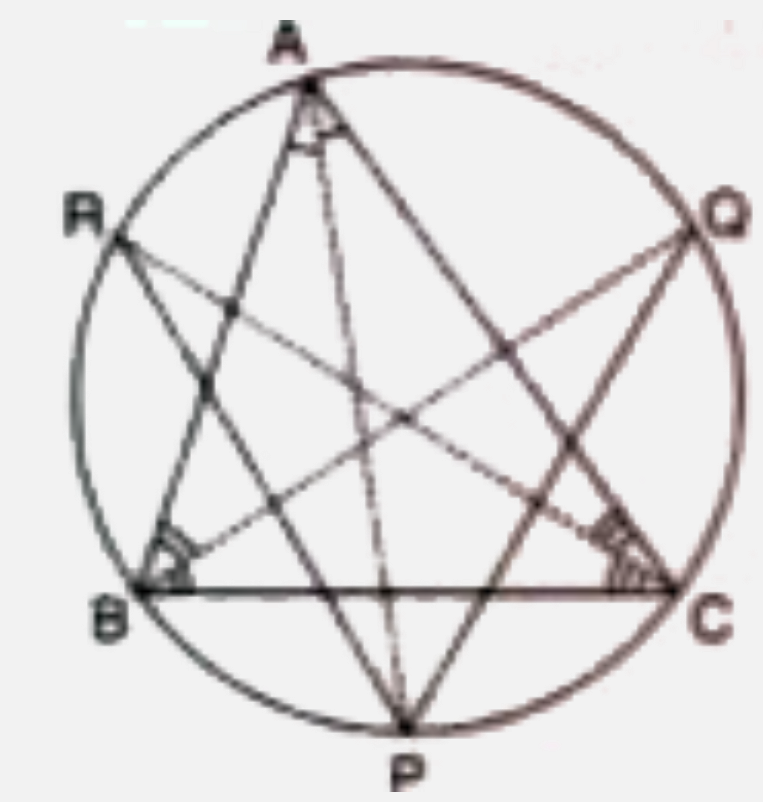Let ABC be a triangle such that ∠A=45∘,∠B=75∘, then a+c√2 is equal to
(a) 0
(b) b
(c) 2b
(d) −b
To solve the problem, we need to find the value of a+c√2 given the angles of triangle ABC where ∠A=45∘ and ∠B=75∘.
1. Determine Angle C:
Since the sum of angles in a triangle is 180∘, we can find ∠C:
∠C=180∘−∠A−∠B=180∘−45∘−75∘=60∘
2. Apply the Sine Rule:
According to the sine rule:
asinA=bsinB=csinC=2R
where R is the circumradius of the triangle.
3. Express a, b, and c in terms of R:
- For a:
a=2RsinA=2Rsin45∘=2R⋅1√2=√2R
- For b:
b=2RsinB=2Rsin75∘
To find sin75∘, we can use the sine addition formula:
sin75∘=sin(45∘+30∘)=sin45∘cos30∘+cos45∘sin30∘
Substituting the values:
=1√2⋅√32+1√2⋅12=√32√2+12√2=√3+12√2
Therefore,
b=2R⋅√3+12√2=R⋅√3+1√2
- For c:
c=2RsinC=2Rsin60∘=2R⋅√32=R√3
4. Calculate a+c√2:
Now we can substitute the values of a and c:
a+c√2=√2R+R√3⋅√2=√2R+R√6
Factor out R:
=R(√2+√6)
5. Relate to b:
From the expression for b:
b=R⋅√3+1√2
To express a+c√2 in terms of b, we can manipulate the expression:
a+c√2=R⋅√2+R⋅√6=R⋅(√2+√6)
We can see that:
a+c√2=2b
Conclusion:
Thus, the final answer is:
a+c√2=2b
Since the sum of angles in a triangle is 180∘, we can find ∠C:
∠C=180∘−∠A−∠B=180∘−45∘−75∘=60∘
According to the sine rule:
asinA=bsinB=csinC=2R
where R is the circumradius of the triangle.
- For a:
a=2RsinA=2Rsin45∘=2R⋅1√2=√2R
- For b:
b=2RsinB=2Rsin75∘
To find sin75∘, we can use the sine addition formula:
sin75∘=sin(45∘+30∘)=sin45∘cos30∘+cos45∘sin30∘
Substituting the values:
=1√2⋅√32+1√2⋅12=√32√2+12√2=√3+12√2
Therefore,
b=2R⋅√3+12√2=R⋅√3+1√2
- For c:
c=2RsinC=2Rsin60∘=2R⋅√32=R√3
Now we can substitute the values of a and c:
a+c√2=√2R+R√3⋅√2=√2R+R√6
Factor out R:
=R(√2+√6)
From the expression for b:
b=R⋅√3+1√2
To express a+c√2 in terms of b, we can manipulate the expression:
a+c√2=R⋅√2+R⋅√6=R⋅(√2+√6)
We can see that:
a+c√2=2b
Thus, the final answer is:
a+c√2=2b
Topper's Solved these Questions
- PROPERTIES AND SOLUTION OF TRIANGLES BOOK - ARIHANT MATHS ENGLISHCHAPTER - PROPERTIES AND SOLUTION OF TRIANGLES EXERCISE - Exercise For Sesssion 2
20 Videos
- PROPERTIES AND SOLUTION OF TRIANGLES BOOK - ARIHANT MATHS ENGLISHCHAPTER - PROPERTIES AND SOLUTION OF TRIANGLES EXERCISE - Exercise For Sesssion 3
34 Videos
- PROPERTIES AND SOLUTION OF TRIANGLES BOOK - ARIHANT MATHS ENGLISHCHAPTER - PROPERTIES AND SOLUTION OF TRIANGLES EXERCISE - SOLVED EXAMPLES
1 Videos
- PRODUCT OF VECTORSBOOK - ARIHANT MATHS ENGLISHCHAPTER - PRODUCT OF VECTORSEXERCISE - Exercise (Questions Asked In Previous 13 Years Exam)
51 Videos
- SEQUENCES AND SERIESBOOK - ARIHANT MATHS ENGLISHCHAPTER - SEQUENCES AND SERIESEXERCISE - Exercise (Questions Asked In Previous 13 Years Exam)
38 Videos
Similar Questions
Knowledge Check
In a ΔABC,if∠A=40∘and∠B=55∘ then ∠C is
A75∘B80∘C95∘D85∘
The given figure shows a triangle ABC with ∠BAC=56∘and∠ABC=64∘, Bisectors of angles A,B and C meet the circumcircle of the ΔABC at points P,Q and R respectively . Find the measure of ∠QPR.

View SolutionIf in a ΔABC,∠A=45∘,∠B=75∘, then
View SolutionDraw Δ ABC with AB = 5 cm, ∠A=60∘,and∠B=75∘. Use only compass and scale for construction.
View SolutionIn a triangle ABC,if B=30∘ and c=√3 b the A can be equal to
View SolutionConstruct Δ ABC with AB = 7 cm, ∠A=30∘,∠B=45∘. Use only compass and scale for construction.
View SolutionIf in a triangle ABC,(s−a)(s−b)=s(s−c), then angle C is equal to
View SolutionConstruct a triangle ABC in which BC=5cm,∠B=60∘and∠C=45∘.
View Solution
